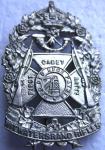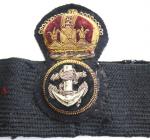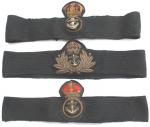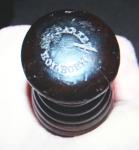-
Posts
13,225 -
Joined
-
Last visited
-
Days Won
22
Content Type
Profiles
Forums
Blogs
Gallery
Events
Store
Everything posted by Mervyn Mitton
-

MODEL LEAD SOLDIERS
Mervyn Mitton replied to Mervyn Mitton's topic in Great Britain: Militaria: Badges, Uniforms & Equipment
The length of the big coach - from rear wheel to leading horse is - 21 inches (53cm) The length of this small coach is 8 inches (20cm) -
The field of collecting model soldiers has always been an active one and crosses all boundaries of class and Country. One has only to visit Blenheim Palace in Oxfordshire to see the enormous collection of Winston Churchill, from when he was a boy. However, I don't recall seeing any posts during my time with GMIC ? There are many British companies who have made models - after all, with three major wars in the 20th. Century they had plenty of incentive - however, the one that stands 'head and shoulders' above the others is Britain's. Their quality has always been first rate and they are known for the attention to detail. With more collectors looking for them, the old Britain's sets have become scarce. The ones I am showing are part of a major collection put together in the fifties and sixties - the first photo show just how big it was - and it was all set around the 1953 Coronation procession. The original owner has now passed away - however, at one time he had it displayed in a shop window, with only a glass pane to keep customers in the shop from touching. The result, when he collected-it - only the items I show were left ! A very good reason not to put things on display without security - like many others I learnt my common sense the hard way. The Queen has many Coaches for different processions - the top one is the Gold Coach - shown here. I think it was made for King George 2nd in the 1740's - but may be older. It weighs several tons and has NO brakes. The postillions control the horses and a number of household pages -wearing the Georgian style Jockey's caps - walk alongside, ready to give help. These are fairly complete in numbers, but the attendent 'Beefeaters' - actually Yeomen Warders of the Tower of London - are mostly missing. I have set the procession out the best I can with the missing pieces. I think this big Coach, with the sides decorated, was the top of the range. They actually made several different models and in the box was a miniature - which I show. Please fill in the gaps and put extra details. Also, would any model collectors like to add-on ? The original photo, showing part of the full collection.
-
What I liked with your post is that they are miniatures. They are so often neglected and whilst they can't be easily researched - or, have a great value - there are still good genuine and inexpensive groups to be bought. Within our ranks I can only think of Noor and Thomas (in Capetown) who regularly show examples. Who else collects mins. ?
-

India General Service Medals
Mervyn Mitton replied to a topic in Great Britain: Orders, Gallantry, Campaign Medals
Darrell -Hi. As always your research is immaculate ! I have to ask - do you do this yourself - or, have a researcher ? Certainly the medals are so much more interesting with it in place. Mervyn -
Hugh - Very interesting and quite frightening. As I get older, mans' 'inhumanity to man', never fails to amaze me....
-
Hi - Dresden. Welcome to GMIC - wow ! two new members on this section in one day.... You must be ex-military to know these special details. Very interesting - please tell us more.
-
Sid - welcome to GMIC. Interesting little items - they remind me of some of the 'cap' dropping bombs* that we had as children in WW2. Because of the interest in the War for children - and the fact that toys often had to be made from re-cycled materials, I wonder if this is what these are ? Does the head unscrew so that one of the old childrens' caps could be laid-in ? The alternative - of course - is that they are some sort of anti-personnel weapons - to be dropped in numbers ? * The caps were in a brown paper and when the carrier was tossed, the weight was in the nose and when it hit the gound it made a sharp 'crack'. The troops often made them for their children in the base workshops - who might have owned these ?
-

Snake buckle belt
Mervyn Mitton replied to Jef's topic in Great Britain: Militaria: Badges, Uniforms & Equipment
We mustn't overlook that many British Police Forces used the 'snake' buckle. -
Two versions of the badges for the Transvall Cadet Corps. The smaller one on the left is for the period 1907-1914. The other one post war.
-
-
The collecting of Cadet Corps material is a big field and attracts people from around the World. I was thinking of Norman when I decided to post these South African examples - he wrote the book on S.A.cadet medals. I had never heard of this particular Regiment having their own cadet corps - and apparantly it only existed for a short period. The Witwatersrand Rifles were set up prior to the Boer War (1899-1902) and their original function was to protect Railway bridges and culverts against Boer attacks. They became a full infantry regiment and still exist as a Territorial unit. I am hopeful that Sth. African collectors will enlarge on my basic post. This badge is the Wits. Rifles 1st Cadet Bn. Pouch Belt Plate. 1907 - 1914
-

NAVAL CAP BANDS
Mervyn Mitton replied to Mervyn Mitton's topic in Great Britain: Militaria: Badges, Uniforms & Equipment
-

NAVAL CAP BANDS
Mervyn Mitton replied to Mervyn Mitton's topic in Great Britain: Militaria: Badges, Uniforms & Equipment
-

NAVAL CAP BANDS
Mervyn Mitton replied to Mervyn Mitton's topic in Great Britain: Militaria: Badges, Uniforms & Equipment
-
I agree with Simon - we don't get enough on Naval - although having said that there have been some interesting recent posts on our submarines and their ops.. To help with momentum I am attaching some shots of Naval cap bands. I had never realised that these were detachable - I suppose for winter and summer caps ? The officer's is straightforward - however, is there any difference in the two petty offs. ? Also, are they WW1 or, WW2 ? There is a possibility that they are Sth. Af. - although I don't think there is much difference.
-
The 1899 pattern cavalry sword was the last in that series and did not have the cut out Maltese cross on the guard. Like all of these slashing swords the weight caused an unbalance when at the 'Charge'. At a full gallop and bringing the sword down caused many of the troopers to literally fall out of the saddle. There is one recorded instance of an entire troop of some 25 men falling off during a charge in the Boer War. This lead to the Royal Commission which brought-in the 1908 . When they brought in the 1908 it changed the entire tactics of a charge - since you were thrusting , not slashing. Several Regiments preferred to keep the older pattern and were allowed to do so - therefore , it is probable, as Jonathan says, that they were in use during the 1st.WW.. The 17th Lancers always preferred the 1853 pattern and carried well into the 20th C. - not sure when they stopped - perhaps they do still carry it for ceremonial duties. ( I think they are now the 17/21/5th Lancers)
-

JAPANESE OCC. TERR. BANKNOTES.
Mervyn Mitton replied to Mervyn Mitton's topic in Coins & Commemorative Medallions
Interesting additions,Bob. This is obviously a collecting field in it's own right. Sam, welcome to the Forum. Would be nice to see some of your collection posted.

















